by Martin Willey
Various art and photo prints were used as decoration in living quarters and recreation centres. See also NASA photos and posters.
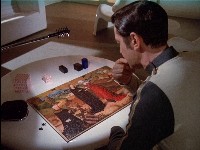
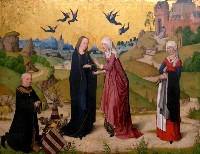
Koenig's jigsaw in Space Brain shows a painting of the Visitation: the pregnant Virgin Mary places her hand on the stomach of Elizabeth - in her womb, the baby John the Baptist leaps for joy. The Late Gothic painting is one of eight depicting the life of the Virgin, painted around 1470 for the church of St Ursula in Cologne, Germany. It is now in the Alte Pinakothek, Munich. The anonymous artist is generally known as the Master of the Life of the Virgin (in German, Meister des Marienlebens). Thanks to Marcus Lindroos. The jigsaw omits much of the golden sky including the angels and the city top right.
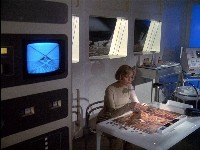
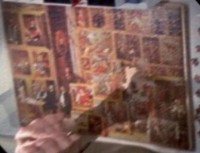
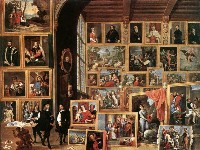
Helena's picture in Space Brain is The Gallery of Archduke Leopold in Brussels painted by David Teniers the Younger around 1650. It is one of a series which depict the Archduke, regent of the Spanish Netherlands, with his collection of paintings (Teniers, in addition to being a court painter, was director of the collection). The canvas is now in the Schleißheim palace in Bavaria. The jigsaw is in fact only a detail; it omits the wooden roof and much of one painting in the top left.
Andreas Cellarius (c1596-1665) was a Dutch-German cartographer, best known for his star atlas Harmonia Macrocosmica, published in Amsterdam in 1660. It depicts the different cosmological systems of the time- Ptolemaic, Copernican and Tychonic, plus maps of the constellations.
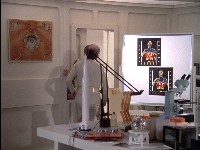
On the wall of Bergman's quarters in Matter Of Life And Death we see the first print by the door. It is still there in Ring Around The Moon, but has gone in Alpha Child
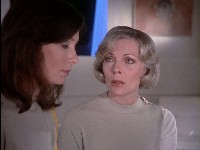
Here it is in Zoref's quarters in Force Of Life

This plate is titled "TYPUS SELENOGRAPHICUS LUNÆ PHASES ET ASPECTUS VARIOS ADUMBRANS" ("Selenographic diagram depicting the varying phases and appearances of the Moon"). The sun is at the top, the Earth in the centre, surrounded by eight moons, depicting each of the phases. The smaller diagram on the right shows the phases over 12 moons marked with lines; the diagram on the left shows the phases as they appear.
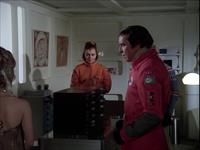
The chart reappears in Recreation Center in One Moment Of Humanity, with a companion print from the same atlas.
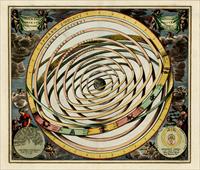
This plate is titled "ORBIUM PLANETARIUM TERRAM COMPLECTENTIUM SCENOGRAPHIA" ("Planetary orbits around the Earth"). This is the Ptolemaic "spheres" system, the standard geocentric model that existed for 1500 years until Copernicus published his heliocentric model in 1543. On the bottom right is a small diagram of the modified geoheliocentric system by Tycho (1587). The Cellarius atlas includes both this geocentric system, the Copernicus heliocentric model and the Tychonic. Galileo and Kepler's observations proved that the Copernican model was correct.
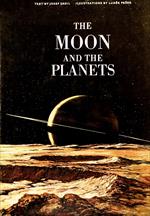
Luděk Pešek (1919-1999) was a Czech/Swiss artist who was renowned for his paintings of space. He illustrated The Moon and the Planets by Josef Sadil, which was translated into English and published by Paul Hamlyn Ltd, London, in 1963. In 1970 he was commissioned to do paintings of Mars by National Geographic, and through the 1970s and 1980s he became well known for his space art for books and planetariums.
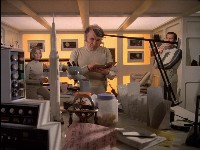
All the art that was used in Space: 1999 appeared in The Moon and the Planets. They may actually come from a copy of the book, but it is more likely they were commercially available prints. They are seen in Victor's quarters and Koenig's quarters. Thanks to Marcus Lindroos and Craig Rohloff for identification.
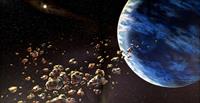
|
p34-5, plate 2: The Nucleus of a Comet Approaching Earth (shown here, as on Alpha, upside down, compared to the book) On the right of the door in Ring Around The Moon, and above Koenig's bed in Collision Course. |
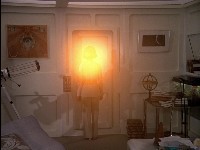
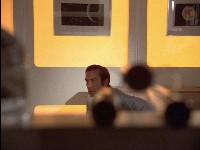 |
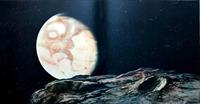
|
p146-7, plate 26: Mars, as it might appear from one of it's two satellites - Deimos In 1972, Pesek made a new version with a red Mars - in the 1963 book, and the Alpha print, it is more yellow. 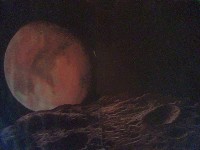
|
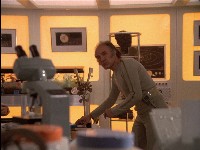 |

|
p150-1, plate 32: The one big vivid spot in Jupiter's southern hemisphere which has given rise to so much speculation |
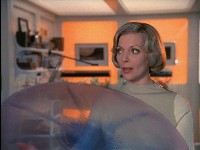
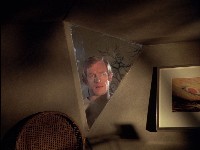
|
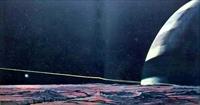
|
p162-3, plate 35: Saturn's chief claim to fame is its rings- the flat light-reflecting bands which encircle the planet |
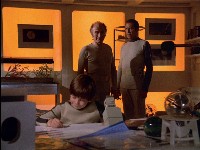
On the left is plate 26, Mars. On the bottom right is plate 38, Uranus. |
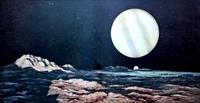
|
p174-5, plate 38: Uranus, as it might look from its satellite Oberon |
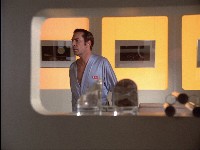 |

The paintings are seen in Helena's home on Earth in Another Time, Another Place. They are all out of frame, except for the reverse angle when the space Alphans look in, revealing p150-1, plate 32, Jupiter's spot.
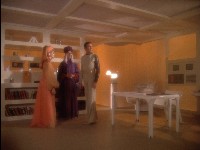
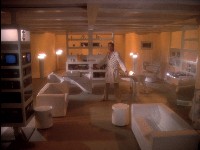
Koenig's quarters in Missing Link has two pictures over his bed, plate 26, Mars, and plate 35, Saturn's rings. On the right in some shots is plate 2, nucleus of a comet.
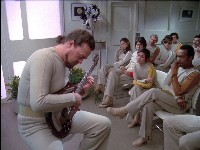
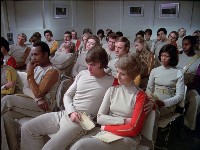
The Recital Room from The Troubled Spirit. Plate 26, Mars, is partially hidden behind artificial flowers. Further along the wall is plate 38, Uranus. On the back wall are plate 35, Saturn's rings, and plate 2, nucleus of a comet.
Two famous prints by British artist David Shepherd appeared in Cellini's living quarters in Dragon's Domain. Born in 1931, Shepherd is a British artist and wildlife conservationist.
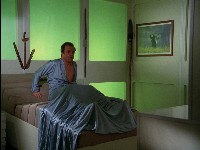
The painting on the wall is "Wise Old Elephant" by David Shepherd. "Wise Old Elephant" was first produced as a poster print by Boots in 1962 and in the 1960s became the best selling print in the world.
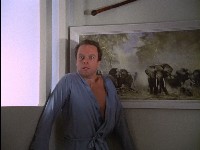
The painting on the wall is "Elephants at Amboseli" by David Shepherd. Another of Shepherd's popular elephant prints.
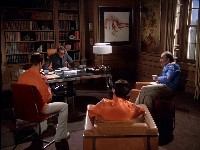
Dixon's office on Earth in Dragon's Domain features a large Keith Wilson painting.
Copyright Martin Willey